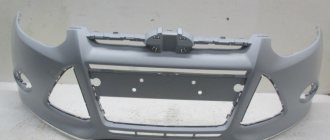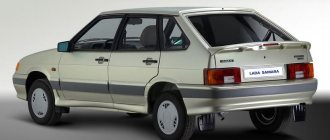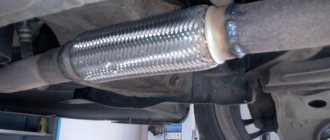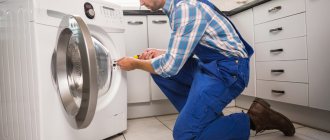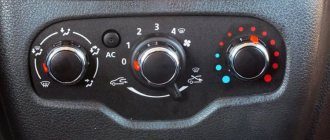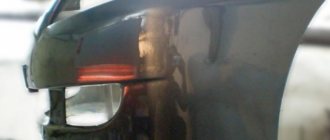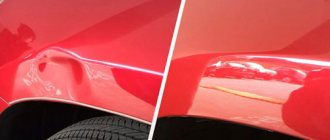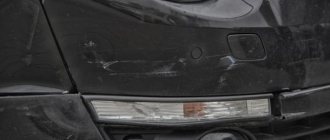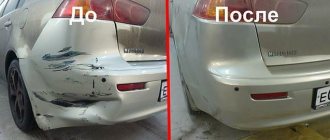How to remove a dent on a bumper with your own hands, without resorting to the services of a service station
Receive one of the most read articles by email once a day. Join us on Facebook and VKontakte.
Many drivers have found themselves in a situation where, in a car collision, there are no casualties and they manage to escape with just the bumper. Meanwhile, repairing this part is not a cheap task, and sometimes you even have to purchase a new body kit element. But the bumper can be repaired, and it’s not at all difficult. Moreover, even large dents can be removed in just 5 minutes, and for this you will need something that is in every home.
Road accidents do not always result in totaled cars and casualties. Usually the situation is just the opposite, and most often the body parts of the car or just the bumper are affected. After a strong collision, the bumper shatters into pieces and is practically irreparable. But the plastic part can withstand a slight blow, after which only a dent remains. It is not always possible to straighten it, and here a simple tool that every person has in their kitchen will come to the rescue.
In order not to resort to the services of repairmen at a service station and save money, we will do the repairs ourselves. First, let's clean the damaged surface. In the event of a collision, paint particles from another car may be transferred to the surface of the bumper. It can be removed using chemicals. First, it's nail polish remover.
which every woman has.
It is worth using it very quickly, since the substance quickly corrodes not only dirt, but can also ruin the original paintwork. The same goes for brake fluid
, which also removes dirt and paint caused by an impact.
But the use of WD-40
less effective, but much safer, since “Vedeha” does not eat paint so aggressively.
Next, we proceed directly to removing the dent. To do this, you will need two containers: one with boiling water and one with cold water. Since the bumper is made of plastic, it softens when exposed to boiling water. If you spill hot water on a part, there is a chance that the bumper will return to its normal shape on its own. If this does not happen, you need to “help” him by sticking your hand under the bumper and “pushing out” the dent from inside the car.
When the impact site straightens, you need to water it with cold water. Then the plastic will cool and take the shape we need. If this is not done, the dent may “return” during natural cooling.
You can also use a hairdryer
, with the help of which the damaged area is warmed up. It’s just that you’ll have to “play around” with household power tools much longer than if you use boiling water.
Did you like the article? Then support us, click
:
Materials of modern bumpers
If you do not take into account old models of Soviet-era passenger cars and some models of modern SUVs, the vast majority of bumpers are made of plastic. Each car manufacturer uses its own compositions, but they have common features that determine the technology for repairing cracks and breaks - gluing or soldering.
There are two large classes of plastics from which bumpers are made: thermoplastic (thermoset) and thermoset. Cracks and breaks in bumpers made of thermoplastic plastic are welded (soldered), those made of thermosetting plastic are sealed.
What type of plastic is determined by the marking:
- thermoplastic - these are all types of polyethylene or polypropylene. In the marking they are necessarily designated as PE or PP (in “pure” form or in combination with other letters of the Latin alphabet). This category also includes tuning bumpers, panels and body kits made of ABS plastic;
- thermosets are polyurethane (PUR), polycarbonate (PC) and fiberglass (unmarked).
Sometimes the first type is called “soft” plastic, and the second is called “hard”. Based on this criterion, it is easy to determine what material the bumper is made of and select an insert for it accordingly.
“Soft” plastics are lighter than water. The density of polyethylene is no more than 0.96 kg/dm 3, polypropylene - about 0.95 kg/dm 3. Only ABS is slightly heavier than water - 1.02-1.06 kg/dm3. When for some reason it is not possible to determine the nature of the material by marking, then it is enough to throw a small piece of plastic into a bucket of water. Polyethylene and polypropylene will float on the surface, a piece of ABS will be semi-submersible, but will not completely “sink”.
“Hard” plastics are heavier than water. The density of monolithic polycarbonate is 1.18-1.2 kg/dm 3, monolithic polyurethane is 1.2-1.25 kg/dm 3, fiberglass is 1.8-2.0 kg/dm 3. And if you throw a piece of hard plastic into water, it will sink.
The process of removing a dent on a plastic bumper
Even experienced drivers sometimes cannot avoid damage to the bumper of their car.
Fixing a dent on a plastic bumper
Driving with a dented bumper is not very good, so the problem will have to be fixed. You can do this by contacting a car repair shop or doing the repairs yourself. If you chose the second option, you will find detailed information about your necessary actions below.
How to repair a crack in a bumper
Repairing cracks in plastic bumpers is also quite simple. After I repaired the first crack, I had no more problems with it. You just need to follow the technology and use high-quality materials.
First of all, it is necessary to drill holes with a diameter of 2-5mm in the places where the crack ends. This must be done to prevent its increase. If this is not done, then even with high-quality soldering and putty, the crack will begin to increase in size over time and you will have to make repeated repairs, which will be more labor-intensive.
After you have drilled the holes, you need to solder a metal mesh along the entire length of the crack on the back of the bumper. For this I used a mesh purchased at a hardware store. A mesh from the air filter of a Kamaz or Ural car is also perfect. It is necessary to cut a piece of mesh that will cover the crack in all directions by 20-30mm. Next, you need to attach the mesh and solder it into the plastic of the bumper with an electric soldering iron. The process of soldering the mesh is very long and tedious, but the overall quality of the crack repair depends on this.
Ideally, the mesh should be completely hidden under the plastic. The thickness of the bumper allows this to be done. However, if the mesh remains partially visible, then upon completion of the repair it should be treated with an anti-corrosion compound. After the mesh is soldered, you should solder the crack on the front side of the bumper, but without using the mesh. After this, you can begin the final cosmetic repairs of the restored area.
Preparatory stage
There are several ways to remove a dent from a plastic car bumper with your own hands. But before you start repairing, you need to understand whether independent restoration is possible in principle. Carry out a thorough inspection to identify any damage. If the crack is too large, and the bumper itself is severely damaged, repairing it yourself is out of the question - you will have to go to a car repair shop. But you can easily handle a small dent and a couple of chips on the plastic bumper on your own.
Before you begin the repair, you need to carry out preparatory work. Remove old paint and dirt from the bumper. To do this, you can use a special paint remover. Failing that, even ordinary acetone-based nail polish remover will do. As a last resort, you can use brake fluid, but it must be washed off as quickly as possible so as not to damage the rest of the coating.
DIY scratch repair
Repairing a plastic bumper with your own hands is much easier if, of all the possible damage, your iron horse escaped with only scratches. For this you will need:
- coarse and fine-grained sandpaper;
- primer for plastic;
- car paint;
- coating varnish.
As a rule, all this is already available in the workshop of an avid car enthusiast.
The first step is to sand the scratch area. What is coarse sandpaper used for? It is worth paying special attention to this so as not to aggravate the problem - if you overdo it, you can deepen the area, while for successful repair it must be absolutely smooth. Next, we pick up a primer, also known as a primer for plastic, and carefully treat the scratch itself in two layers. Between applying the first and second coats, as well as before continuing to repair scratches on the bumper, it should take from half an hour to forty minutes.
Next comes cosmetic procedures. The area treated with primer is sanded with fine-grained sandpaper, dust and accumulated debris are removed and paint is applied. To completely hide a scratch, three or four layers are enough, but you should be extremely careful.
To ensure that the painted area does not stand out, it is necessary to select a paint that matches the overall color and tone, and also allow the layer to dry completely before applying the second one.
The final touch is to apply several layers of varnish to fix the paint. After such a thorough repair, your car will be ready for use in exactly 24 hours.
Dent removal process
To carry out repair work to remove dents from a plastic bumper with your own hands, you will need:
- rubber or construction gloves to avoid damaging your hands;
- electric kettle or saucepan with boiling water;
- large container with cold water.
Removing dents with boiling water
To straighten the bumper, you can use a special hair dryer or simply boil water in an electric kettle. You can simply do this in your garage. The last method may seem dubious to you, but in practice many have already been convinced of its effectiveness. This is what we will look at in more detail.
Tools and materials
A dent in a plastic bumper can be easily repaired if you use the right quality tools. Moreover, when doing such work with your own hands, it is important that the product being repaired is carefully prepared in advance. As for the complexity of the tools needed to straighten a dent, in many cases you can use simple tools that do not require investing a lot of money.
To repair a plastic bumper, ridding it of dents, you must prepare the following materials and tools in advance:
- hairdryer When selecting it, it is imperative to pay attention to its power, which is why it makes sense to give preference to construction and other industrial devices that can heat up even thick-walled products well;
- boiling water. It is used for the same purposes as a hair dryer, and sometimes instead of it. Boiling water has a gentle effect on plastic products and that is why it is sometimes used to replace an industrial hair dryer. You can prepare it using an ordinary household electric kettle. You can bring it to the work site and prepare boiling water as needed;
- a screwdriver or other metal object with a blunt end;
- household or protective gloves. They are necessary to protect your hands from burns if they are accidentally exposed to hot air or boiling water;
- magnet for straightening metal parts or elements.
What you need to repair a bumper
To properly repair a plastic bumper without painting, you will need the following tools or materials:
hair dryer It is very important that it produces the necessary power, so it is best to give preference to industrial models;- boiling
water It can be used together with a hairdryer or instead of it (or you don’t have to use it if you have a hairdryer). To make repairs without painting, you will need from one to several liters - it all depends on the size, depth and complexity of the dent being repaired; - a straight metal object with a blunt end
. This could be an ordinary screwdriver or similar tool; - gloves
. The most ordinary ones will do. Their task is to protect the master’s hands from accidental exposure to boiling water or hot air; - can of compressed air.
Preparing for repairs
A dent on a bumper can be deep or shallow, with or without damage to the paint layer. That is why, before starting to repair it, you must first inspect the damaged area and decide whether it is possible to carry out the repair in principle. If the bumper has cracks or other significant damage, repairing it is impractical and it would be better to buy a new product to replace the broken one. If the bumper looks slightly dented, it is quite possible to straighten it yourself.
In addition to a visual inspection, before starting repair work, it is necessary to clean the surface of the bumper from old paint and dirt. Since plastic is a fragile material, you should not use metal objects or emery for such cleaning. It is best to use special paint and varnish removers. In any case, they should not be aggressive. If you don’t have anything at hand, take regular brake fluid, but it is advisable to quickly wash it off so that it does not damage the paintwork remaining on the bumper.
Heating method
Tools and materials used:
- high temperature hair dryer;
- grinder with polishing and grinding wheels;
- degreasing liquid;
- putty;
- paints and varnishes.
Work production technology
Set of shaped spacers for straightening bumpers
- The assembly is removed, and repair of the plastic bumper begins with complete cleaning of this part of the car. All fasteners and foreign objects are removed.
- The boundaries of the defective zone are outlined. The damaged working surface is degreased and dried.
- The defect is heated from the inside of the part to prevent the paint layer from burning out. The process of softening the polymer should be done as quickly as possible so as not to affect neighboring areas.
- After the material acquires elasticity, leveling is performed. Impacts should not be applied to the car bumper, but to a special shaped gasket with rounded edges.
- After giving the area its original shape, the front side of the working area should be cleaned of caked paint. Sanding is carried out with a slight approach to undamaged areas of the coating so that the edges do not stand out.
Dent removal algorithm
Repairing a dent on a plastic bumper is carried out in accordance with the following algorithm:
- the part is dismantled in order to have equal access to both its outer and inner surfaces;
- The dent area is thoroughly washed and dried, ensuring that its entire surface is dry and clean on both sides. Traces of rust, dirt, and fungus that could interfere with the normal course of the restoration process are strictly excluded;
- After preliminary preparation, it is necessary to level the bumper with a hairdryer, gradually warming it up. The entire repaired area must be uniformly heated to a temperature at which the plastic bumper softens, but there is no need to bring it to the melting point and you should press on it carefully during the work process. If this rule is not followed, the bumper will have to be repainted;
- Warming up the product with a hairdryer, or pouring hot water on it, we pull out the dent with gradual circular movements, pressing on it from the side. It would be great if this type of dent straightening is done using a blunt metal object.
- After warming up the bumper, you should wait a few minutes before straightening the dent, since under the influence of high temperatures, it can begin to straighten itself, returning to its previous state;
- after the part has taken on the old or received a new shape, and the dent has been eliminated, the bumper needs to be cooled at the site of damage using a wet rag, as well as a can of compressed air.
Remember that heated plastic is easily deformed, so you can only straighten it evenly on all sides.
Separately, it is worth noting that in the manuals devoted to the topic: how to remove a dent on a bumper, it is specifically stated that some types of plastics have “shape memory.” It lies in the fact that when repairs are carried out a relatively short time after the bumper has received damage, it can return to its previous shape somewhere in 10-15 minutes after the end of heating the product. If the bumper is cooled in time, it will be fixed in a new state and will never return to its previous state. As for putting it back in place, this can only be done when the damper has completely cooled down and is not afraid of serious mechanical impacts.
How to fix a dent
To properly repair a dent on a front or rear plastic bumper without painting, you must follow the following algorithm:
- Dismantle the part . Typically, both front and rear bumpers can be easily removed. This will help you a lot when working, because most likely you will need an approach to both the external and internal sides of the part.
- Thoroughly wash and dry the part being repaired. The entire surface of the damage must be clean and dry on both sides. There should be no traces of dirt, mildew or rust on the bumper.
- Gradually heat the deformed part of the plastic bumper using a hairdryer or pour boiling water over it. In this case, the entire area should be heated as evenly as possible. It should be remembered that plastic should never be brought to a state in which it begins to melt. Otherwise, repairing the bumper without subsequent painting will simply be impossible.
Using a hair dryer to remove a dent on the bumper
- As the bumper heats up, you need to gradually press the dent from the back side with rotating movements. For this you will need a blunt metal object.
You should take into account the fact that heated plastic is very malleable, and therefore in no case should you put too much pressure on only one part of the dent - it should all be pulled out evenly.
If a dent has formed where the rib of the bumper passes, then first you need to level it. After this, it will be easier for you to restore the rest of it. In some cases, the plastic itself will begin to return to its place under the influence of temperature. In such a situation, you don’t even need to use a screwdriver or similar object - it will be enough just to heat it evenly and make sure that it does not start to melt. The ability or inability of plastic to return to its place on its own depends on its type and structure.
DIY bumper repair
- After the bumper repair has been completed and the dent has been completely pulled out, it is best to cool the area of deformation using a can of compressed air or just a wet rag. The thing is that some types of plastic bumpers have a “memory” of shapes. And if the repair is carried out several weeks or even months after the damage was sustained, then during this time the plastic bumper could “remember” the new shape, and 5-10 minutes after the repair the dent will begin to appear again. Using a wet cloth or compressed air will secure the material in its new position.
- After the part has completely cooled, it can be installed in its original place.
If you did everything correctly, you can consider that removing a dent from a plastic bumper without painting was successful.
The bumper is intended to absorb impacts. And it is not surprising that scratches, cracks and even holes appear on it. But if the idea is not about a representative car, but about a work car, then most minor and medium-sized damage can be repaired yourself.
What to do with difficult dents
It is easy to straighten the bumper if it is plastic and does not have serious damage, but if it is metal, it will be more difficult to correct the situation. To do this, you need a magnet that is magnetized to the edge of the dent. After this, it is heated with boiling water, pouring it over the surface of the dent. Next, the magnet is pulled towards itself with force, gradually moving it towards the center of the dent. As a result, it should at some point straighten out, making a characteristic sound. The metal parts on the plastic bumper are aligned in the same way.
If deep dents appear on the plastic bumper, use the original method. To do this, take a powerful hair dryer and use it to heat the area around the damage. Next, the heated dent is cooled using a can of compressed air until frost appears on it. After the frost melts, the dent should disappear, since the plastic should “remember” the shape it previously had.
conclusions
The design of modern car bumpers and the technical properties of the materials used for their manufacture make it possible to carry out most repair work yourself. To do this, you need to be careful and careful not to use unnecessary physical force and damage the bumper. However, complex dents should be entrusted to the attention of professionals, since they may be located in inconvenient places, or their independent removal may lead to failure of this element of the car’s structure.
How to straighten a damaged bumper with your own hands: home methods
One of the common situations, especially in the winter season, is the appearance of dents on the car bumper. They arise in the process of “collision” with snowdrifts. Even a small interaction like this can result in a decent amount of money that you will have to pay at a car service for its restoration. But it’s easy to straighten a plastic bumper with your own hands. You need to purchase the necessary tools and become familiar with the stages of the work.
Preparatory work
Those vehicle owners who were unlucky enough to escape with a slight scare and a few scratches on the bumper have to look for ways to restore the damaged part. Repairing bumpers with your own hands at home requires some skill, consumables and tools. In addition, you should correctly select the technology for restoring a plastic part, taking into account the type of polymer material and its composition, and also follow the sequence of work.
The choice of repair method depends on several factors:
- type of polymer;
- degree of damage;
- financial capabilities of the car owner.
You can find out what kind of plastic the bumper is made of by looking at the markings on the back of the part. This information is important because not all types of plastic can be soldered.
Preparatory work includes searching for and purchasing plastic, as well as metal mesh for applying patches (if necessary), mixtures for sanding, putty and painting, sandpaper, spatulas, a soldering iron and a grinder.
Surface preparation
Before straightening the bumper, you need to find out exactly what it is made of.
If the bumper material cannot be heated, then squeezing out the defect with your own hands will be problematic, and in this case it is better to seek help from body repair professionals.
For example, you should not heat an existing welded seam on a bumper, nor should you heat a fiberglass part.
To remove a dent, you must first remove the bumper and use a hair dryer to slightly warm the surface. At the same time, the water in the kettle is heated to a temperature of 40 degrees. Heated water is poured over not only the defect itself, but also an area with a radius of 20 cm around it. Then you need to heat the water again to a temperature of 50 degrees and repeat the procedure.
Bumper heating
- To straighten a dent, you need to properly remove all the stress created by the deformation. This can be done by heating the plastic and applying the right amount of force. When heating a dent, you also need to heat 10–15 cm around it. By doing this, you relieve the tension in the area around the dent created by the impact.
- For heating, you can use available means such as a hair dryer or boiling water. Other means that help to more evenly heat the entire deformation zone at the same time are exposure to an infrared lamp (drying), as well as dipping the damaged part into a bath of hot water. We will consider all these means below.
- Consider the thickness of the plastic before applying heat to the dent. On some modern cars, the plastic is very thin and can easily overheat.
- If the plastic is not hot enough, the deformation will not ease and, when straightened, will return. On the other hand, if you overheat the plastic, it will become much more difficult to repair. It will stretch unnecessarily when pressed. When plastic is overheated and on the verge of melting, strength and elasticity deteriorate as it cools. Therefore, it is important to heat the bumper to the correct temperature and not overdo it.
- There are cases when stronger heating of the plastic is necessary in certain places. For example, to remove folds formed during deformation.
- When using a hair dryer, you need to heat the bumper until the surface is hot when touched. The ideal temperature for heating the bumper is between 160–200 degrees. When heating the bumper, you need to hold the hair dryer nozzle close to the surface to control the heat, but no closer than 10 cm. Move the hair dryer evenly at a moderate speed to properly warm up the plastic. Excessive heat may cause the paint to bubble. At this temperature, the plastic can change shape with moderate force. Don't forget that you need to heat not only the dent, but also the area around it. When using a hair dryer, use its highest setting. A hair dryer is best used on medium settings. If the dent is large, then you can use two hair dryers. It is better to have a second person help.
- When using hot water to straighten a dent, you need to boil a full kettle or pan of water. Hot water will make the plastic more flexible. Such heating will not last long, so you need to do everything very quickly. You need to get to the other side and press. We will look at dent correction in more detail below.
If a dent has formed on the ribs of the bumper, then after heating you need to press directly on the ribs.
- To straighten the dent, the bumper can be immersed in a bath of hot water (80–90 degrees Celsius) for several minutes. Part of the dent may return on its own, but the rest must be straightened by hand after removal from the bath. To remove any remaining deformation, you can apply local heat with a hairdryer set to the desired temperature.
- Infrared drying can be used to heat the damaged area. Drying can be considered a less accessible heating method, but effective. It is used in body repair and car painting. Drying softens a large area, and the dent becomes pliable and all stress is relieved. No matter how deep the dent is, it will heat up evenly and return easily without significant effort. In addition, if the plastic is well heated, there is less chance of small cracks appearing in the paint after straightening.
Straightening
Do-it-yourself bumper dent removal should begin immediately to prevent the water from drying out. The magnet must be brought to the surface and moved in different directions. Moreover, even if the bumper is plastic, it will be magnetic, since the paint applied to it contains a large number of metal particles.
From the inside, we gently press the dent with our hands to straighten it to its previous position. This way you can help the magnet and simultaneously distribute the force over the entire surface of the bumper. To remove a dent, you do not need to press too hard with your hands, as this can damage its coating.
Once recovery is complete, do not immediately remove your hands. You should hold the straightened surface for a few minutes to secure the new shape.
But the restoration work is not finished yet. To remove a dent completely with your own hands, you need to heat the water again to a temperature of 35 degrees and pour it over the bumper. This procedure is carried out several times, and each time the temperature drops by 8 degrees. When the water temperature is 15 degrees, the bumper is left to dry in a cool and dry place. Here it should lie for 48 hours, after which it can be reinstalled in its place.
How to straighten the shape (dent) of a plastic bumper using hot water
“Minor” accidents are a kind of mass scourge, when somewhere or something is touched, jammed, it seems not critical - a small thing, but unpleasant. As a result, if the damage in an accident is not significant, and as we understand the majority of such accidents, then the bumper is the first to suffer. It doesn't matter if it's a front or rear bumper. For us now it is more important that the bumper be made of plastic. Since if the bumper is plastic and bent, dented, changed shape, then this is a fixable matter... It is precisely this scenario, when the bumper was jammed during a minor accident and the process of its restoration that we will talk about in our article.
Before we start talking about how to restore the shape of plastic, we will tell you a little about the fact that almost all materials have some kind of “memory” of their original shape. Of course, the word memory is used here in a somewhat unusual context. It means that if a material has changed its shape under the influence of external forces, this means with a high degree of probability that it can be returned to its original forms if favorable conditions are created for the possibility of restoration. Well, if we expressed ourselves too complicated or unclear, then it is better to see once than to read a hundred times. Let's just look at an example where the front plastic bumper was jammed during an accident, and then straightened using improvised means.
The process of straightening a jammed plastic bumper on a car
So, in our case we have a damaged, namely jammed, left corner of the front bumper. It is important to note that it remained without cracks or tears. If in your case there are similar damages (ruptures, etc.), then it is better to refer to another article, “Repairing a plastic bumper with your own hands.” The integrity of the bumper surface will provide some guarantee that the bumper can still be straightened.
As we know, plastic is a plastic material, especially under the influence of temperature. So, in order to provoke this plasticity, it is necessary to heat the plastic. You can heat the plastic in different ways. You can use a hairdryer, or heat water in a kettle or pan on the stove. This is exactly the method we used in our case.
We pour heated water, up to about 90-95 degrees, over the plastic in the place where we need to deform it. We water the plastic until it warms up. As we have already said, plastic can also be heated with a hairdryer. Here you need to be more careful, since you can locally overheat the plastic, which can cause it to stretch, or the paint will bubble or peel off. Water will provide more uniform heating and faster. After this, you can try to restore the original shape by pressing on the plastic in the opposite direction of the force that led to the actual deformation. Simply put your hand inside the bumper and press on the damaged area.
In most cases, plastic will restore the original appearance, at least as close as possible to it.
It will simply be plastic and straighten out. It should be noted that if the damage is not significant, that is, the bumper is not very jammed, then it can recover almost on its own. To do this, you can park the car on a sunny summer day in the sun, which will heat up the plastic and it will restore its shape. Such cases also occur! From this we can conclude that all restoration procedures are best carried out in the warm season, or in a warm room. In winter it will be much more difficult.
So, this option for restoring the bumper, if there were no sharp breaks or tears, will be quite possible and even a desirable combination of circumstances. This is what we wanted to talk about in our article. Let's say more. This option can practically eliminate all costs associated with bumper repairs, thereby saving your money, time and nerves.
www.autosecret.net
Repairing complex dents
It happens that deeper dents appear on the bumper than those left after contact with snowdrifts. The reasons for their occurrence can be different, ranging from children playing with a ball to road accidents. To level out such a dent, it is not at all necessary to contact specialists. All work can be done with your own hands.
There is an effective and simple method. To straighten a dent, you will need a powerful hair dryer, which heats the area around the damage for a couple of minutes. Next, the heated dent is sprayed with a can of compressed air until traces of frost from the liquefied air appear. Afterwards, you should wait for the frost to disappear and observe the surface straightening on its own. All that remains is to wipe the dent until a natural shine is formed.
So, you can always fix a dent that appears on the bumper with your own hands, which will save significant money.
